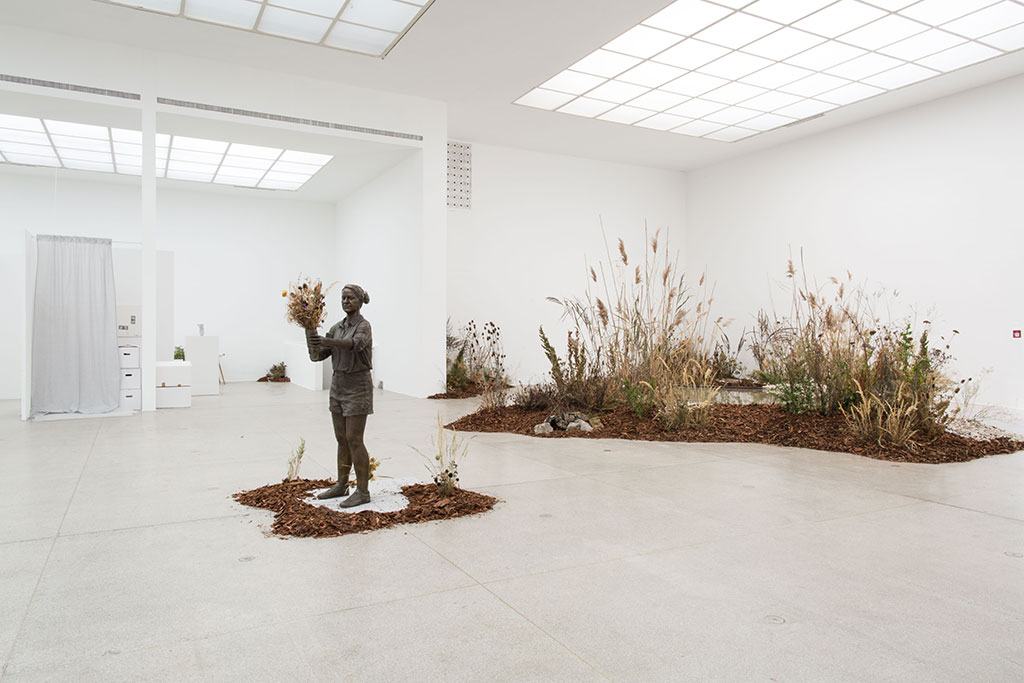ART CITIES:Vienna-Verena Dengler

Verena Dengler makes art that is richly allusive, trenchant, and occasionally provocative. Astute observations of the art world with its mechanisms and historically contingent conditions as well as the artist’s own entanglements in it are often the subject of installations, objects, pictures, drawings, texts, videos (and a whole lot more) that offer reflections in which critique is leavened by humor and satire.
By Dimitris Lempesis
Photo: Vienna Secession Archive
In “Die Galeristin und der schöne Antikapitalist auf der Gothic G’stettn (Corona Srezessionsession Dengvid-20” [The gallery owner and the beautiful anti-capitalist on the Gothic G’stettn (Corona recession session Dengvid-20)] Verena Dengler builds a “landscape” consisting of a pond and a surrounding overgrown urban wasteland or “Gstettn” that serves as the setting for other works and elements. The descriptive title outlines the exhibition’s thematic compass: “The Gallery Owner and the Beautiful Anti-Capitalist” points to a literary project set in the art world in which the artist avails herself of the stylistic conventions of the dime novel or penny dreadful. Working, through Skype, with the German theater and film actress Astrid Meyerfeld and the artist Leon Kahane, she has adapted excerpts for the “silver screen” releasing the footage on her Instagram account. The clips offer a decidedly facetious take on mechanisms of the art scene and market and on artists’ attempts at social-media image-building and self-marketing. The pond quotes the layout of the Hirschstetten swimming hole, a recreational area in one of Vienna’s outlying residential districts, where the artist herself lives and gestures toward the implicitly hierarchical distinctions between periphery and center, between natural and man-made landscapes—concerns that are also at stake in the trope of the “Gstettn” The peculiar interpretation of the latter as a “Gothic Gstettn” blends the image of the urban wasteland with Romantic-era depictions in which the natural landscape is steeped in mystery and deeper meaning and the notion of nature as pristine to obtain an emblem of an anarchic counterculture. The bronze sculpture represents a woman holding a bouquet in one hand and an iPhoneς with broken screen in the other to take a picture of the flowers. The figure strikes the characteristic pose that Barbara Urbanic, the self-described “hobby horticulturist with creative urges and revolutionary zeal” assumes when she snaps flowers for her Instagram account @stadtblume_wien. The grand piano in the exhibition stands for quality, the proud embrace of tradition, and cultural values, yet it is also an indicator of the challenges of a global market: the “Secession,” whose design was inspired by characteristic elements of the building’s architecture is the first collector’s item in Bösendorfer’s new “Architecture Series”. The mock trade fair stands and booths in the exhibition, which Dengler built out of modular wall system components, make for a deliberately heavy-handed allusion to the commercialization of art and its commodity status. In fair booth H88 on the right, Galerie Meyerheim presents blue-chip art; across the room, the same enterprise, now styling itself galerie.meyerheim projects_, showcases the work of hip young artists. The curtains between the booths partition off storage rooms holding art that has been brought to the scene but is not on display. The name “Meyerheim” for the gallery is taken from the “Meyerheim-Poem” by Theodor Fontane; it is an anti-Semitic code designating a Jewish capitalist. Finally, the coinage Dengvid-20 in the title, unmistakably a play on Covid-19, anchors the show in the present with its sweeping measures enacted to curb a global pandemic. The crisis has had an immediate and especially severe impact on many freelancers; reality has borne out Dengler’s critique of the economic framework in which art is created and the precarious circumstances in which artists often live. The pun Srecession, meanwhile, only thinly disguises the specter of a prolonged economic downturn, which might be precipitated by many causes, a pandemic among them.
Info: Curator: Bettina Spörr, Association of Visual Artists – Vienna Secession, Friedrichstraße 12, Vienna, Duration: 3/7-8/11/20, Days & Hours: Tue-Sun 14:00-18:00, www.secession.at


